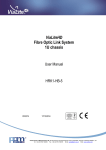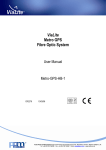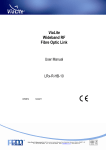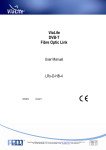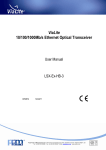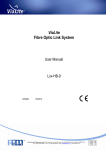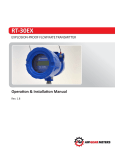Download ViaLiteHD Quick Start Guide
Transcript
ViaLite quick start guide www.vialite.com PPM ViaLiteHD Quick Start Guide This quick start guide is intended as an information summary, the relevant equipment handbook should always be treated as the master document. Initial Inspection Unpack and inspect the equipment as soon as possible. If there is any sign of damage or any parts missing, do not install the equipment before seeking advice from PPM or your local agent. The equipment received should match the delivery note that is shipped with the equipment. If there are any discrepancies, contact PPM or your local agent. Electrical Safety ViaLiteHD HPS Power Supply Units are Safety Class 1 products (having metal case directly connected to earth via the power supply cable). The unit is also fitted with an earthing/grounding stud connected to the power supply earth. When operating the equipment note the following precautions: Hazardous voltages exist within the equipment. There are no user serviceable parts inside; the covers should only be removed by qualified technician. The equipment does not have a mains isolating switch. Equipment must be installed within easy reach of a dual pole mains isolation switch. There are no user replaceable fuses in the rack mounted equipment. Replacement should only be carried out by a PPM technician. ESD Precautions Precautions for handling electro-static sensitive devices should be observed when handling all ViaLiteHD modules. Technicians should ensure that they use effective personal grounding (i.e. ESD wrist strap etc..) when servicing the equipment. Any equipment or tools used should be grounded to prevent static charge buildup. Good practice should be observed at all times for reference see relevant standards. EN 61340-5-1, “Protection of Electronic Devices from Electrostatic Phenomena – General Requirements” Optical Safety The ViaLiteHD RF Transmitter modules contain laser diode sources operating at nominal wavelengths of 1270nm to 1610nm. These devices are rated as EN60825-1:1994 CLASS 1 radiation emitting devices. A class 1 laser is safe under all conditions of normal use. When operating the equipment note the following precautions: Never look into the end of an optical fibre directly or by reflection either with the naked eye or through an optical instrument. Never leave equipment with radiating bare fibres – always cap the connectors. Do not remove equipment external covers when operating. ViaLiteHD and ViaLite Classic compatibility The RF and optical interfaces of ViaLiteHD and ViaLite Classic are compatible. Hence it is possible for units of different types to interwork and be used to expand existing systems. However the physical size, mounting systems and control of the units are different, so it will not be possible to mix systems in a single rack or housing. Contact PPM for more details. Cleaning optical connectors Optical connectors MUST be cleaned before use. Most performance issues are due to dirty fibres. - Peel the plastic cover from an unused “N” cleaning pad. - Hold the connector between your thumb and forefinger Clean the connector using firm pressure by swiping in a pendulum motion through each segment of the “N” shape, following the diagram - Do not swipe over the same space twice. For more details please read the cleaning instruction which accompanies the connector cleaning kit. Details can also be found on the CD supplied with your equipment. Blindmate Optical and RF Connectors Note that the ViaLiteHD Blindmate system will simultaneously mate electrical, RF and optical backplane connectors, so both RF and optical connectors need to be prepared. Firstly inspect the rear Blindmating plate, ensure that the connector barrels are fitted into all RF connectors and are centrally aligned. Remove any protective covers from the optical connectors. Fit the Blindmating plate into the appropriate slot at the rear of the rack. For module installation see the following section. Connect the external system cables to optical and RF interfaces. External interface SMA RF connectors should only be connected with a calibrated SMA torque spanner. External optical interface SC/APC adaptors are fitted with a sprung protective cover. To connect SC/APC optical connectors, remove the plug protective cover. Open the adaptor sprung cover, align the connector keyway slot in the adaptor to the key of the plug. Gently push the plug into the adapter until a click is heard and the connector locks. To disconnect, grip the body of the plug and gently pull the plug from the adaptor, replace the protective cover. Hxx-QS-HB-2 VialiteHD Quick Start Guide Page 1 CR2896 ViaLite quick start guide www.vialite.com Standard Optical Connectors and Fibres Ensure that all mating connectors are matched types. To connect SC/APC optical connectors, remove the connector protective cover. Align the connector keyway slot in the adaptor to the key of the plug. Gently push the plug into the adapter until a click is heard and the connector locks. To disconnect, grip the body of the plug and gently pull the plug from the adaptor, replace the protective cover. To connect E2000/APC optical connectors. Gently push the plug into the adapter until a click is heard and the connector locks. To disconnect, depress the lever of the plug and withdraw the connector. The protective cover engages and disengages automatically. To connect LC/APC optical connectors, remove the connector protective cover. Gently push the plug into the adapter until a click is heard and the connector locks. To disconnect, depress the lever of the plug and withdraw the connector, replace the protective cover. All PPM FC/APC equipment use narrow key FC/APC connectors, these are not compatible with wide key FC/APC. To connect FC/APC optical connectors, remove the protective cover and align the white ceramic centre ferrule on the cable connector with the mating receptacle. There is a key on the side of the ferrule, which must match the keyway slot in the receptacle shroud. When they are aligned, gently push the plug home and finger tighten the knurled collet nut onto the threaded receptacle. Disconnection is the reverse of connection; replace the protective covers on both the receptacle and the cable plug. Minimum Bend Radius of a simplex patch cable is typically 30mm, at this radius there will be a very small increase in loss due to the bend (~0.05dB) Connecting and Disconnecting RF Connectors This product uses a range of RF connectors. Please ensure that RF connections are made with correctly matched connectors and cable impedances. Failure to do so may result in damage to the connectors and loss of performance. SMA RF connectors should only be connected with a calibrated SMA torque spanner. BNC connectors are available in both 50 and 75 ohms. RF Module Input/Outputs Levels RF inputs and outputs should not be exposed to DC voltage levels in excess of ±36V. Absolute maximum no damage RF input level is +13dBm (some units will tolerate more, see handbook). Absolute maximum no damage RF level applied to an RF output is +13dBm. Some transmitter modules are pre-configured to have a DC voltage present on the RF input connector, to drive low noise amplifiers and similar equipment. Check module handbook and description for more details. All receiver modules will create a 1-2Vpeak DC transient from the RF output at start up into a 50Ω load (approximately 5V into a 1MΩ load). This may cause failure in some very sensitive spectrum analyzers or similar equipment. All modules have AC coupled inputs and/or outputs and will be sensitive to large transients (>5V) applied to either input or output. This may result in permanent damage to the units, particularly to low frequency units. Contact PPM for more details. Some receiver modules are equipped with DC loads on their outputs, please see module handbook. 19 Inch Rack Installation The ViaLiteHD 19” Rack Case is designed to fit 19” cabinets. Two options are available that occupy a height of either 1U or 3U; both have flanges for cabinet mounting. The 3U rack case provides mounting for 16 modules, 13 general purpose slots (1-13), 1 dedicated controller slot (14) and 2 dedicated power supply slots (15,16). The 3U Rack Case must be used with at least one plug-in HPS Power Supply Module, power inputs are situated at the rear of the rack with one dedicated power connection per module. The backplane contains 9-way D-type data connectors for each module position 1-13; this provides user access to module data. The rack case provides two 50 way connectors (SCSI-3 Har-mik® female) that give access to power, alarm and rack data. The mating SCSI-3 connector can be terminated with either a ribbon or individual round cable, contact PPM for more details. The pin-outs of these connectors are given in the following section. Either power supply position can be used; the power supplies are designed to current share, if more than 1 is fitted. If power supplies are operating in redundant configuration, there should be a minimum load of 20 watts to ensure that both power supplies are active, below this level one power supply may be in idle mode. A dummy load board can be supplied, to fit into any of the unused slots. The 1U rack case provides 3 slots and 1 power supply draw. These slots can be factory configured either for 3 general purpose slots (1-3) or for 2 general purpose slots (1-2) plus 1 controller slot (3). The 1U rack case provides two 25 way standard density D connectors that give access to power, alarm, module data and rack data. The pin-outs of these connectors are given in the following section. Controller Front RJ45 Ethernet Interface Hot swappable modules Test Port A Test Port B Status LED1 Status LED2 Status LED3 Handle Release Button PSU Status LED Guide Pin Handle Slot 1-13 General Purpose Modules Removable Fan Cassette Fan Power Connector Blindmate Plates Blindmate Optical Interface Controller Craft Port Slot 14 Controller Reset Controller Slots 15-16 Button Module Power Supply Controller Optical Modules Interface (Optional) Module Data Connector Mounting flange Fully Enclosed Fan Controller Rear 2xRJ45 Ethernet Interface Rack Connector J1 Rack Connector J4 PSU Power Connection IEC60320/C13 Hxx-QS-HB-2 VialiteHD Quick Start Guide Blindmate RF Interface Standard Modules Page 2 Standard Optical Interface Standard RF Interface CR2896 ViaLite quick start guide www.vialite.com Rack Case Summary Pinout Pin Rack J1* Pin Rack J1* Pin Rack J1* Pin Rack J1* 1 2 3 4 5 6 7 8 9 10 11 12 13 GND ALARM_2 ALARM_4 ALARM_6 ALARM_8 ALARM_10 ALARM_12 ALARM_14 ALARM_P_2 GND Analogue_monitor_B_2 Analogue_monitor_B_4 Analogue_monitor_B_6 14 15 16 17 18 19 20 21 22 23 24 25 26 Analogue_monitor_B_8 Analogue_monitor_B_10 Analogue_monitor_B_12 GND GND Analogue_monitor_A_1 Analogue_monitor_A_3 Analogue_monitor_A_5 Analogue_monitor_A_7 Analogue_monitor_A_9 Analogue_monitor_A_11 Analogue_monitor_A_13 ALARM_1 27 28 29 30 31 32 33 34 35 36 37 38 39 ALARM_3 ALARM_5 ALARM_7 ALARM_9 ALARM_11 ALARM_13 GND ALARM_P_1 Analogue_monitor_B_1 Analogue_monitor_B_3 Analogue_monitor_B_5 Analogue_monitor_B_7 Analogue_monitor_B_9 40 41 42 43 44 45 46 47 48 49 50 Analogue_monitor_B_11 Analogue_monitor_B_13 GND GND Analogue_monitor_A_2 Analogue_monitor_A_4 Analogue_monitor_A_6 Analogue_monitor_A_8 Analogue_monitor_A_10 Analogue_monitor_A_12 GND Pin Rack J4* Pin Rack J4* Pin Rack J4* Pin Rack J4* 1 2 3 4 5 6 7 8 9 10 11 12 13 CSB Relay_terminal_2 GND GND GND +12Vdc +12Vdc +12Vdc +12Vdc +12Vdc +12Vdc +12Vdc +12Vdc 14 15 16 17 18 19 20 21 22 23 24 25 26 GND LNA_feed_2 LNA_feed_4 LNA_feed_6 LNA_feed_8 LNA_feed_10 LNA_feed_12 GND GND GND GND GND Relay_terminal_3 27 28 29 30 31 32 33 34 35 36 37 38 39 Relay_terminal_1 GND GND GND +12Vdc +12Vdc +12Vdc +12Vdc +12Vdc +12Vdc +12Vdc LNA_feed_1 GND 40 41 42 43 44 45 46 47 48 49 50 LNA_feed_3 LNA_feed_5 LNA_feed_7 LNA_feed_9 LNA_feed_11 LNA_feed_13 GND GND GND GND GND Note: Colour indicates relevant connector drawing * Optional custom cable available for use in ViaLite system Contact No 25 Contact No 1 No.1 contact 1 5 6 9 Contact No 50 2 x 4-40 UNC thread Contact No 26 Rack connector: View looking into connector 50 way SCSI-3 Har-mik® female Module connector: View looking into connector 9 way D-Type connector female (DE-9) The analogue monitor functions are dependent on the type of module, see below Function Transmitter (single) Receiver (single) Transceiver Dual Transmitter Dual Receiver Analogue_monitor_A Analogue_monitor_B Laser bias monitor Not Used Not Used Received light level Laser bias monitor Received light level Laser bias monitor A Laser bias monitor B Received light level A Received light level B Installation of Plug-in Modules HPS power supply plug-in modules can be installed by pushing the release button of the module handle down and simultaneously pulling the top of the handle forwards. Align the module so that the PCB slides into the “crow’s feet” with the module upright and perpendicular to the front face of the rack. Gently push the module down its guide, applying pressure via the handle and the outmost curved face (do not apply pressure to the ventilation grill). As the module is fully mated the top of the handle should snap back and lock in position. Addition resistance will be experienced as the low resistance backplane connector engages. The pawls of the handle should be fully engaged in the matching slots. To disconnect the module, push the release button of the module handle down and simultaneously pull the top of the handle forwards. Apply pressure via the handle and withdraw the module from the rack. Blind mate modules can be installed by pushing the release button of the module handle down and simultaneously pulling the top of the handle forwards. Remove the protective cover from the modules optical connectors. Clean the module optical connector. Align the module so that the PCB slides into the “crow’s feet” with the module upright and perpendicular to the front face of the rack. Gently push the module down its guide, applying pressure via the handle, as the module is fully mated the top of the handle should snap back and lock in position. The pawls of the handle should be fully engaged in the matching slots. To disconnect a module, push the release button of the module handle down and simultaneously pull the top of the handle forwards. Applying pressure via the handle and gently withdraw the module from the rack, replace the protective covers on the optical connectors. Standard and controller modules can be installed by pushing the release button of the module handle down and simultaneously pulling the top of the handle forwards. While installing the protective covers may be left in place on RF and optical connectors. Align the module so that the PCB slides into the “crow’s feet” with the module upright and perpendicular to the front face of the rack. Gently push the module down its guide, applying pressure via the handle, as the module is fully mated the top of the handle should snap back and lock in position. The pawls of the handle should be fully engaged in the matching slots. To disconnect a module, remove any cables you do not want to withdraw, push the release button of the module handle down and simultaneously pull the top of the handle forwards. Applying pressure via the handle and gently withdraw the module from the rack, replace the connector protective covers. All ViaLiteHD plug-in modules are hot-swappable, so it is not necessary to power-down the rack case before inserting a module. It is advised that all unused slots be fitted with blanking panels. Different width blanking panels are available; these fit the 5HP general purpose, 6HP power supply, 7HP controller card slots. They can be used in all ViaLiteHD racks cases and will prevent accidental/unwanted access and the ingress of dust. When operating RF fibre optic links the ideal operating input power is dependent on the end users system. However in all cases there will be the desire to achieve the optimal signal quality (ratio of signal to noise plus distortion). At low signal power this will be dominated by thermal noise and at high signal powers it will be dominated by distortion products. Typically a good quality signal can be obtained by operating the link at a composite input power 20dB below the fibre optic module’s P1dB specification level (see handbooks). The backplane has data connectors for module positions 1-13; this provides access to module data. The pin-outs of these connectors are given in the following section Pin Module Pin Rack Summary Pin Rack Summary 1 2 3 GND TX_422_IN+ TX_422_IN- 4 5 6 TX_232_IN GND RX_422_OUT+ 7 8 9 RX_422_OUTRX_232_OUT RST_485 Note: Colour indicates relevant connector drawing Connections in Blue are optional and only available on some types of module Hxx-QS-HB-2 VialiteHD Quick Start Guide Page 3 CR2896 ViaLite quick start guide www.vialite.com Front Panel Indicators The following table shows the operation of the front panel LEDs Plug-in modules Colour LED1 GREEN Flashing GREEN RED No light GREEN Flashing RED fast Flashing RED slow RED GREEN Flashing GREEN AMBER LED2 LED3 Plug-in Transmitter (single) Plug-in Receiver (single) Programming TX PSU fail Not used Programming Not used RX PSU fail TX Alarm Not used Not used Not used RX Alarm Not used Plug-in Transceiver Normal Programming TX PSU fail RX PSU fail Normal TX Alarm RX Alarm All Alarm I2C enabled I2C active I2C disabled Plug-in Dual Transmitter Plug-in Dual Receiver Programming TXA PSU fail TXB PSU fail Programming RXA PSU fail RXB PSU fail TXA Alarm TXB Alarm All Alarm RXA Alarm RXB Alarm All Alarm LED1 LED2 LED3 Manual control The Plug-in Modules can be manually configured to set various operational parameters. The dual in line package (DIP) switches that control these configurations are located on the bottom side of the PCB and can be accessed by withdrawing the module by approximately a third of its length. One, two or three sets of switches will be installed dependent on the type of module. To enable manual gain control the TX_MGC or RX_MGC switch must be set to ON ( in some manual units the MGC may automatically be enabled). The gain can then be decreased from a maximum (all attenuators = OFF) by changing the TX or RX attenuator settings. The gain setting for the Transmitter or Receiver will depend on the sum of the attenuators set (ON= gain reduced by attenuator value, OFF = no gain reduction for that attenuator). The gain can only be changed by approximately 0.5dB steps. Depending on configuration, some units will also allow the control of the I2C bus, VSAT power supply, LNB power, special GPS functions and automatic gain control. More details are provided in the fibre optic module handbooks. Quick commissioning of ViaLiteHD fibre optic link This short commissioning procedure illustrates the processes required to install and set up a communications link with gain control. 1. 2. 3. 4. 5. 6. 7. 8. 9. 10. 11. 12. Install the cards in the desired location within the rack, using the installation process as described earlier in this quick start guide. Remove any dust covers from your cross site fibre (or patch leads) and the connectors on the cards (if applicable). Clean the cross-site cable as described within this quick start guide. Insert fibre into the connectors on the rear of the rack/card ensuring that any keyway is aligned Power up the equipment (both ends of the link), all cards should have 2 GREEN LED’s and 1 AMBER LED. If any LED is RED or FLASHING RED then check fibre connections for cleanliness and that they are correctly fitted. If this does not remover the RED LED’s then consult the full detailed manual (HRxHB or HRK-HB) for the comprehensive fault finding procedure Connect all RF cables to the RF connectors on the rack cards. Allow the equipment to warm up for 15 minutes. Ensure that the RF power into the transmitter module is set to optimum for your system. Use a broadband RF power meter for this measurement. Typically this is the input level at which the link’s intermodulation distortion (IMD) is -40dBc. This value of input power is given in the datasheet for each type of ViaLiteHD fibre optic link. Calculate the approximate optical attenuation in the fibre path. As an example, if we have two bulkhead connectors (0.2dB attenuation for each), 1500m of optical fibre (for 1310nm laser, attenuation is 0.4dB per km) giving a total of 1dB of optical loss. The total RF gain of the system should be the nominal link gain minus 2 x the optical loss. For manually set gain control, adjust the gain via the SNMP GUI (where SNMP is fitted) or the dip switches on the card to the appropriate level required. For automatic gain control set up AGC as shown the full system manual (HRx-HB). Confirm that the RF output from the receiver is correct (to within measurement accuracy). If the loss is much higher (>3dB) than expected, the most likely explanation is dirt on the optical connectors. If this is the case, clean each connection in turn until the required system gain is restored. ViaLiteHD user manuals All Vialite HD user manuals are available on the CD that is shipped with each order; they can also be accessed from the www.vialite.com web site. In all cases the handbook should always be treated as the master document. PULSE POWER AND MEASUREMENT LTD., 65 SHRIVENHAM HUNDRED BUSINESS PARK, SWINDON, SN6 8TY, UK. TEL: +44 1793 784389 FAX: +44 1793 784391 EMAIL: [email protected] W EBSITE : WWW.VIALITE.COM Hxx-QS-HB-2 VialiteHD Quick Start Guide Page 4 CR2896






